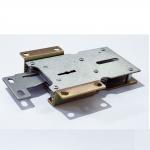High Security Mechanical Safe Lock Anti Interference For Portable Safes
|
|
I. Structural ComponentsLock Cylinder Types: Common types include pin tumbler locks (controlled by pin arrangements) and wafer tumbler locks (using wafer angles to match keys). High-security models may use sidebar locks or magnetic locks. Materials: Brass or stainless steel; premium cylinders may incorporate anti-drill ceramic plates. Lock Bolt Design: Straight bolt, hook bolt, or rolling bolt, some with anti-saw hardening treatments.
Keyhole Protection: Dust covers, anti-pry plates, or non-standard shapes (e.g., cross, crescent) to prevent tool insertion. Auxiliary Structures Spring System: Ensures automatic bolt resetting, requiring corrosion-resistant materials. Lock Housing: Made of cast steel or alloy, often reinforced with anti-drill steel plates.
II. Working PrinciplesKey Matching The unique teeth or magnetic points on the key align precisely with the internal structure (pins, wafers) of the lock cylinder to release the lock. Mechanical Transmission Key rotation drives a transmission rod inside the cylinder, retracting the bolt. Some designs use multi-stage transmission for enhanced complexity.
Security Mechanisms Anti-Picking Features: False pins, labyrinth grooves, etc., to resist lockpicking. Self-Locking Mechanism: Triggers a lockout after repeated incorrect attempts to prevent brute-force attacks.
III. Pros and Cons AnalysisAdvantages Passive Reliability: No power required; suitable for extreme temperatures or humidity (e.g., basements, outdoor use). Anti-Interference: Immune to electromagnetic pulses or signal disruptions, ideal for high-security backup systems. Quick Access: Instant operation without system delays, critical in emergencies. Disadvantages Physical Vulnerability: Low-end locks are prone to drilling/sawing; require reinforced housings. Key Management Risks: Traditional keys are easily copied; high-security keys (e.g., laser-engraved, bidirectional magnetic) need authorized duplication, increasing costs. Limited Functionality: Lacks remote monitoring or usage logs, relying solely on physical security.
IV. Application ScenariosHome Safes: As primary or backup locks alongside electronic systems. Small Businesses: Secure storage for documents or cash in environments without stable power. High-Security Facilities: Redundant locks in bank vaults or museums, often integrated with electronic systems. Portable Safes: Lightweight yet tamper-resistant designs for travel or temporary storage.
V. Maintenance and TroubleshootingRoutine Maintenance Cleaning: Use compressed air to clear keyhole dust quarterly; clean keys with alcohol-dipped cotton swabs. Lubrication: Apply graphite powder or specialized lubricant; avoid grease to prevent debris buildup. Troubleshooting Key Insertion Issues: Check for bent keys or foreign objects in the keyhole. Bolt Jamming: Adjust bolt screws or inspect spring elasticity. Emergency Measures Lost Key: Contact the manufacturer for cylinder replacement (proof of ownership required). Tampering Signs: Report to authorities immediately and verify asset security.
|
| Product Tags: High Security Mechanical Safe Lock Mechanical Safe Lock Anti Interference Portable Safes Security Mechanical Lock |

|
Secure Your Fireproof Gun Cabinets with Durable Zinc Alloy Handles and Mechanical Key Lock |

|
High Security Mechanical Safe Lock Anti Interference For Portable Safes |

|
Anti Picking Mechanical Key Lock for Home Safes or Small Businesses |

|
OEM Mechanical Key Lock For Safes , Gun Safe Mechanical Lock With 2 Keys |


